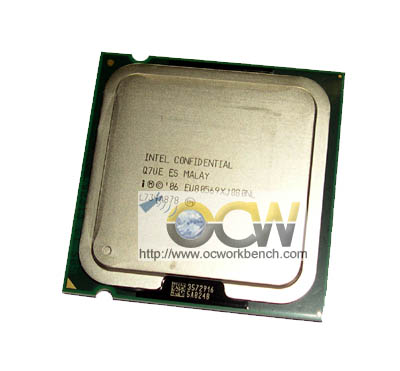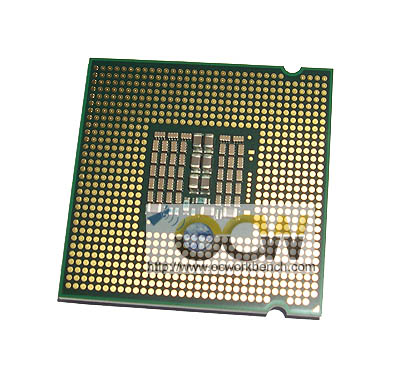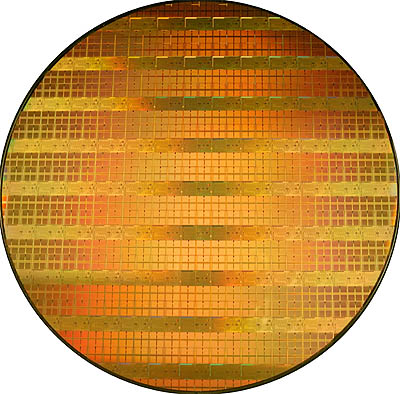The 45nm SSE4 capable processor
Today, Intel officially lifted the embargo on it's latest Core 2 Extreme
Processor. This new processor named QX9650 is a quad core processor build on
45nm manufacturing process technology.
Clocked at 3GHz (1333MHz FSB), this new processor comes with a larger 12MB L2
Cache and the newer SSE4 instructions set. The QX9650 is also lead-free.


45nm
So how small is 45nm ? In a comparison with real life objects, we can see
that 45nm is why too tiny, even smaller than a bacteria of 2K nm in size. The
original transistor built by Bell Labs in 1947 could be held in your hand, while
hundreds of Intel’s new 45nm transistors can fit on the surface of a single red
blood cell. You could fit more than 2,000 45nm transistor gates across the
width of a human hair. That is how small 45nm is.
45nm Size Comparison
o A nail = 20 million nm
o A human hair = 90,000nm
o Ragweed pollen = 20,000nm
o Bacteria = 2,000nm
o Intel 45nm transistor = 45nm
o Rhinovirus = 20nm
o Silicon atom = 0.24nm

SSE4
From the early days of Floating point extensions in 8086 to the SIMD and
Intel MMX technology. All these technologies helped to achieve increase
parallelism in the P5 microarchitecture through the use of special instructions
that operate on multiple pieces of data simultaneously. The MMX technology
delivered better performance in media application such as graphics, video
streaming and gaming by loading loading it into MMX technology registers.
In P6, Intel introduced SSE (Streaming SIMD Extensions) designed for P3. SSE
extended MMX and allowed SIMD computations on 4 packed Single precision FP using
128 bits registers. With P4, Intel introduced SSE2 (and MMX). It allowed more
simultaneous computation in parallel enabling support of 128 bit integers and
packed double precision FP data types. In SSE2, 144 new instructions were added
to increase performance across applications. The SSE2 help enhanced the
performance of Mpeg2, mp3 and 3D graphics.
SSE3 in the P4 added 13 more instructions to improve thread synchronisation and
x87 Floating point math capability.
In Penryn, SSE4 will offer dozens of new innovative instructions in two major
categories:
• SSE4 Vectorizing Compiler and Media Accelerators
• SSE4 Efficient Accelerated String and Text Processing
Vectorizing Compiler and Media Accelerators
The new compiler vectorization primitives include improved integer
and floating-point operations, support for packed DWORD and QWORD
operations, new single precision FP operations, fast register operations,
performance-optimized memory operations, and more.
Applications that will benefit include those involving image processing,
graphics, video processing, 2-D/3-D generation, multimedia, gaming,
memory-intensive workloads, HPC workloads, and more.
Efficient Accelerated String and Text Processing
SSE4 provides new string and text processing instructions that will
enhance the performance of string and text processing operations,
resulting in a performance boost for a wide variety of data processing,
search, and other text-based applications. These new instructions
will include advanced packed string comparison instructions
that can perform multiple compare and search operations in a single
instruction. In general, each of these new instructions has a rich set
of innovative string processing capabilities to replace operations
in which several instructions were required to deliver the same
functionality in the previous ISA.
Applications that will benefit include those involving databases,
text search, virus scanning, string process libraries like ZLIB, Token
parsing/recognizing applications like compilers, and state machine oriented
applications.
Here are some of the specifications of this processor:
-
3.0GHz 1333MHz FSB Quad Core
-
45nm high K metal gate transistor technology
-
12MB L2 cache
-
SSE4 instructions
-
820M transistors
-
214mm2 die size
-
LGA775 Socket 130 TDP C-step
-
Overspeed protection removed
-
Supported by all Intel P35 or X38 chipset mainboards (with bios upgrades).
In the subsequent pages, we take a look at some of the benchmarks, comparing
the new QX9650 with the older brother QX6700 (o/c to 3.0GHz at 333x9) clock to
clock at 3GHz.
Next >>>